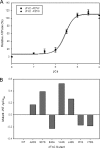Predicting cardiomyopathic phenotypes by altering Ca2+ affinity of cardiac troponin C
- PMID: 20566645
- PMCID: PMC2934646
- DOI: 10.1074/jbc.M110.112326
Predicting cardiomyopathic phenotypes by altering Ca2+ affinity of cardiac troponin C
Abstract
Cardiac diseases associated with mutations in troponin subunits include hypertrophic cardiomyopathy (HCM), dilated cardiomyopathy (DCM), and restrictive cardiomyopathy (RCM). Altered calcium handling in these diseases is evidenced by changes in the Ca(2+) sensitivity of contraction. Mutations in the Ca(2+) sensor, troponin C (TnC), were generated to increase/decrease the Ca(2+) sensitivity of cardiac skinned fibers to create the characteristic effects of DCM, HCM, and RCM. We also used a reconstituted assay to determine the mutation effects on ATPase activation and inhibition. One mutant (A23Q) was found with HCM-like properties (increased Ca(2+) sensitivity of force and normal levels of ATPase inhibition). Three mutants (S37G, V44Q, and L48Q) were identified with RCM-like properties (a large increase in Ca(2+) sensitivity, partial loss of ATPase inhibition, and increased basal force). Two mutations were identified (E40A and I61Q) with DCM properties (decreased Ca(2+) sensitivity, maximal force recovery, and activation of the ATPase at high [Ca(2+)]). Steady-state fluorescence was utilized to assess Ca(2+) affinity in isolated cardiac (c)TnCs containing F27W and did not necessarily mirror the fiber Ca(2+) sensitivity. Circular dichroism of mutant cTnCs revealed a trend where increased alpha-helical content correlated with increased Ca(2+) sensitivity in skinned fibers and vice versa. The main findings from this study were as follows: 1) cTnC mutants demonstrated distinct functional phenotypes reminiscent of bona fide HCM, RCM, and DCM mutations; 2) a region in cTnC associated with increased Ca(2+) sensitivity in skinned fibers was identified; and 3) the F27W reporter mutation affected Ca(2+) sensitivity, maximal force, and ATPase activation of some mutants.
Figures





Similar articles
-
Challenging current paradigms related to cardiomyopathies. Are changes in the Ca2+ sensitivity of myofilaments containing cardiac troponin C mutations (G159D and L29Q) good predictors of the phenotypic outcomes?J Biol Chem. 2008 Nov 28;283(48):33119-28. doi: 10.1074/jbc.M804070200. Epub 2008 Sep 26. J Biol Chem. 2008. PMID: 18820258 Free PMC article.
-
A mutation in TNNC1-encoded cardiac troponin C, TNNC1-A31S, predisposes to hypertrophic cardiomyopathy and ventricular fibrillation.J Biol Chem. 2012 Sep 14;287(38):31845-55. doi: 10.1074/jbc.M112.377713. Epub 2012 Jul 18. J Biol Chem. 2012. PMID: 22815480 Free PMC article.
-
Engineered troponin C constructs correct disease-related cardiac myofilament calcium sensitivity.J Biol Chem. 2012 Jun 8;287(24):20027-36. doi: 10.1074/jbc.M111.334953. Epub 2012 Apr 17. J Biol Chem. 2012. PMID: 22511780 Free PMC article.
-
Mouse Models of Cardiomyopathies Caused by Mutations in Troponin C.Int J Mol Sci. 2023 Aug 2;24(15):12349. doi: 10.3390/ijms241512349. Int J Mol Sci. 2023. PMID: 37569724 Free PMC article. Review.
-
Biochemical characterisation of Troponin C mutations causing hypertrophic and dilated cardiomyopathies.J Muscle Res Cell Motil. 2014 Apr;35(2):161-78. doi: 10.1007/s10974-014-9382-0. Epub 2014 Apr 18. J Muscle Res Cell Motil. 2014. PMID: 24744096 Review.
Cited by
-
Functional characterization of TNNC1 rare variants identified in dilated cardiomyopathy.J Biol Chem. 2011 Sep 30;286(39):34404-12. doi: 10.1074/jbc.M111.267211. Epub 2011 Aug 5. J Biol Chem. 2011. PMID: 21832052 Free PMC article.
-
Molecular basis of calcium-sensitizing and desensitizing mutations of the human cardiac troponin C regulatory domain: a multi-scale simulation study.PLoS Comput Biol. 2012;8(11):e1002777. doi: 10.1371/journal.pcbi.1002777. Epub 2012 Nov 29. PLoS Comput Biol. 2012. PMID: 23209387 Free PMC article.
-
The missing links within troponin.Arch Biochem Biophys. 2019 Mar 15;663:95-100. doi: 10.1016/j.abb.2018.12.026. Epub 2018 Dec 22. Arch Biochem Biophys. 2019. PMID: 30584890 Free PMC article. Review.
-
Why Is there a Limit to the Changes in Myofilament Ca2+-Sensitivity Associated with Myopathy Causing Mutations?Front Physiol. 2016 Sep 26;7:415. doi: 10.3389/fphys.2016.00415. eCollection 2016. Front Physiol. 2016. PMID: 27725803 Free PMC article. Review.
-
Long-timescale molecular dynamics simulations elucidate the dynamics and kinetics of exposure of the hydrophobic patch in troponin C.Biophys J. 2012 Oct 17;103(8):1784-9. doi: 10.1016/j.bpj.2012.08.058. Epub 2012 Oct 16. Biophys J. 2012. PMID: 23083722 Free PMC article.
References
-
- Pollesello P., Ovaska M., Kaivola J., Tilgmann C., Lundström K., Kalkkinen N., Ulmanen I., Nissinen E., Taskinen J. (1994) J. Biol. Chem. 269, 28584–28590 - PubMed
-
- Sorsa T., Heikkinen S., Abbott M. B., Abusamhadneh E., Laakso T., Tilgmann C., Serimaa R., Annila A., Rosevear P. R., Drakenberg T., Pollesello P., Kilpelainen I. (2001) J. Biol. Chem. 276, 9337–9343 - PubMed
-
- el-Saleh S. C., Solaro R. J. (1987) J. Biol. Chem. 262, 17240–17246 - PubMed
-
- Chandra M., Rundell V. L., Tardiff J. C., Leinwand L. A., De Tombe P. P., Solaro R. J. (2001) Am. J. Physiol. Heart Circ. Physiol. 280, H705–H713 - PubMed
Publication types
MeSH terms
Substances
Grants and funding
LinkOut - more resources
Full Text Sources
Other Literature Sources
Medical
Miscellaneous

